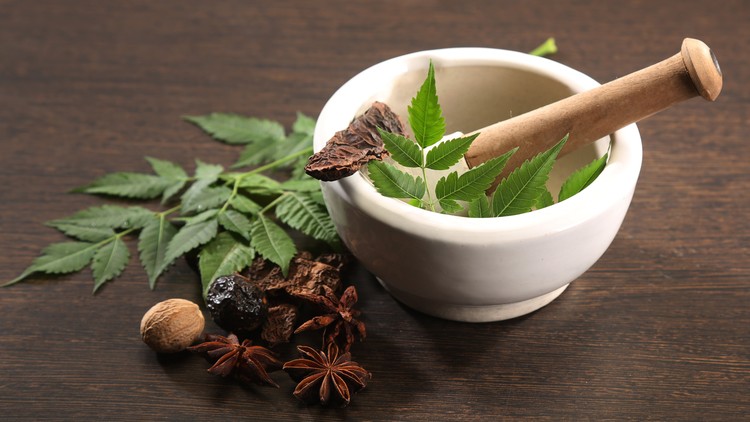Certificate Course in the Fundamentals of Ayurveda
- Description
- Curriculum
- FAQ
- Reviews
Namaste,
I am excited to welcome you to the world of Ayurveda and promote experiential learning!!
This course covers the core concepts of Ayurveda, based on the ancient text Charak Samhita. It is meant only for those who want to understand the scientific logic behind the basics of Ayurveda in detail and also learn to live an Ayurveda lifestyle.
The course consists of multiple video lectures. Each video lecture is followed by a crisp animated recap video. Plus, there are short multiple-choice quizzes, practical exercises, and resources to help you absorb the essence of each lecture.
Topics covered
All about Ayurveda
-
What is Ayurveda?
-
What is Veda?
-
Duration of Life
-
Aim of Ayurveda
-
Source of Ayurveda
-
Definition of Ayurveda
-
Origin of Ayurveda
Branches of Ayurveda
-
Kaya Chikitsa
-
Shalya Tantra
-
Agad Tantra
-
Bhoot Vidya
-
Shalakya Tantra
-
Kaumarbhritya
-
Rasayan
-
Vajikaran
Basics of Triguna
-
The Tamasic Person
-
The Rajasic Person
-
The Satvic Person
-
Triguna-Stages of Evolution Final
-
Triguna-The Game of Life
Introduction to the Guna (Properties- Spiritual, Comparative, Sensory, Physical)
-
What is Padarth?
-
What is not Padarth?
-
The Master of The Matrix
-
Samvaay- The Integrity of a Substance
Introduction to Dravya (The Concept of Substance according to Ayurveda)
-
What is Dravya?
-
Dravya – The Ability to Create
-
Dravya – The Independent Existence
-
The Nine Elements
-
The Integral properties of elements
-
The Formation of the Five Great Elements
-
How the five elements combine
-
The Soul Element
-
The Mind Element
-
The Time Element
-
The Direction Element
-
The Space Elements
-
The Air Element
-
The Fire Element
-
The Water Element
-
The Earth Element
-
The Triguna in the Five Great Elements
What is a Dosha?
-
The Tripod of Tridosha
-
The Vata Dosha
-
The Pitta Dosha
-
Kapha Dosha
-
Doshas All Around You!
-
The Doshas in the Universe
-
Doshas Story in the Context of Organizational Functions
All about the Vata Dosha
-
The Drying Effect of Vata Dosha
-
The Cooling Vata Dosha
-
The Lightness of Vata Dosha
-
The Subtle Vata Dosha
-
The Mobility of Vata Dosha
-
The Clarity of Vata Dosha
-
The Roughness of Vata Dosha
All About the Pitta Dosha
-
The Acidity of Pitta
-
The Pungent Taste of Pitta
-
The Fluidity of Pitta
-
The Liquidity of Pitta
-
The Sharpness of Pitta
-
Pitta Oiliness
-
The Strong Body Odours of Pitta
-
The Heat of Pitta
All About the Kapha Dosha
-
The Heaviness Of Kapha Dosha
-
Cooling of Kapha Dosha
-
The Stability of Kapha Dosha
-
Sliminess of Kapha Dosha
-
Oiliness of Kapha Dosha
-
The sweetness of Kapha Dosha
-
Stickiness of Kapha Dosha
-
The softness of Kapha Dosha
-
The slowness of Kapha Dosha
Abodes of Vata Dosha
-
Bones
-
Ears
-
Sense of Touch
-
Thighs
-
Large Intestine
-
Pelvic Girdle
Abodes of Pitta Dosha
-
Eyes
-
Lymph
-
Stomach
-
Pitta Sense of Touch
-
Umbilicus
-
Tissue Fluid
-
Sweat
-
Blood
Abodes of Kapha Dosha
-
Throat and Head
-
Amashaya
-
Adipose Tissue
-
Your Chest
-
Rasa
-
Joints
-
Kloma Pancrease or Palate
-
Sense of Smell
Subtypes of Vata Dosha
-
Prana Vayu
-
Udana Vayu
-
Saman Vayu
-
Vyana Vayu
-
Apana Vayu
Subtypes of Pitta Dosha
-
Pachak Pitta
-
Ranjak Pitta
-
Sadhak Pitta
-
Bhrajak Pitta
-
Alochak Pitta
Subtypes of Kapha Dosha
-
Kledaka Kapha
-
Avalambak Kapha
-
Bodhak Kapha
-
Shleshak Kapha
-
Tarpak Kapha
Imbalance in Doshas
-
Prominent Signs of Vata Excess
-
Prominent Signs of Pitta Excess
-
Prominent Signs of Kapha Excess
Agni – The Fire Inside
-
The Concept of Agni
-
The Concept of Koshthagni
-
How does the Koshthagni work?
-
The Concept of Dhatuagni
-
How does the Dhatuvagni work?
-
The Concept of Bhutagni
Dhatu – The Ayurvedic Tissue System
-
The Seven Dhatu
-
Rasa – The Tissue Fluid
-
Rakta – The Blood
-
Mansa – The Muscular Tissue
-
Meda – The Fatty Tissue
-
Asthi – The Bony Tissue
-
Majja – The Marrow
-
Shukra – The Reproductive Tissue
Ojas – The Life Force
Prakriti The Ayurvedic Body Constitution
-
What is Prakriti or the Ayurvedic Constitution?
-
How does the Prakriti Form?
-
What are the types of Ayurvedic Constitutions?
-
What are the Element Based Body Types?
-
What are the Dosha-based Body Types?
-
How the Ayurvedic Body Type Theory was rediscovered by a Western Physician?
-
Can your parents’ body type affect yours?
-
What’s the effect of your mother’s food, lifestyle, and mind on your Prakriti?
All About The Vata Body Type
-
What is the normal Vata Height?
-
What’s the normal weight for Vata people?
-
How is the face of a Vata person?
-
How is the skin of a Vata person?
-
Discover the hair type of a Vata person
-
How is the normal respiration of a Vata person?
-
How does the circulation of a Vata person work?
-
How does the digestive system of a Vata person work?
-
How are the joints of a Vata person?
-
The normal excretion of a Vata person
-
How does the nervous system of a Vata person work?
-
How is the memory of a Vata person?
-
How is the normal behavior of a Vata person?
-
How is the sleep of a Vata person?
The Pitta Body Type
-
What is the normal Pitta Height?
-
What’s the normal weight for Pitta people?
-
How is the face of a Pitta person?
-
How is the skin of a Pitta person?
-
Discover the hair type of a Pitta person
-
How is the normal respiration of a Pitta person?
-
How does the circulation of a Pitta person work?
-
How does the digestive system of a Pitta person work?
-
How is the normal excretion of a Pitta person?
-
How does the nervous system of a Pitta person work?
-
How is the memory of a Pitta person?
-
How is the normal behavior of a Pitta person?
-
How is the sleep of a Pitta person?
The Kapha Body Type
-
What is the average height and weight of a kapha person?
-
How is the face of a kapha dominant person?
-
How is the skin of a kapha-dominant person?
-
How is the hair of a kapha-dominant person?
-
How is the digestion of a kapha-dominant person?
-
How is the respiration of a kapha-dominant person?
-
How is the circulation of a kapha-dominant person?
-
How is the excretion of a kapha-dominant person?
-
How is the nervous system of a kapha-dominant person?
-
How is the sleep of a kapha-dominant person?
-
How is the behavior of a kapha dominant person?
Calculate your body type
Rasa Panchak ( Elements of Food)
-
What is Rasa Panchak?
-
What is Rasa?
-
Elements in Rasa
-
Movement of Rasa
-
Combinations of Rasa
-
What is Anurasa?
-
Examples of Anurasa
Special Metabolic Impacts of Rasa
-
Properties of Sweet Taste
-
Effects of Excess Sweet Taste
-
Properties of Sour Taste
-
Effects of Excess Sour Taste
-
Properties of Salty Taste
-
Effects of Excess Salty Taste
-
Properties of Pungent Taste
-
Effects of Excess Pungent Taste
-
Properties of Bitter Taste
-
Effects of Excess Bitter Taste
-
Properties of Astringent Taste
-
Effects of Excess Astringent Taste
The Ayurvedic Concept of Potency (Virya)?
-
What is Virya?
-
Primary types of Virya
-
Heat Creating potency and its Impact
-
Coolness Creating Potency and Its Impact
-
Vipaka- The Post-Digestion Taste Transformation
-
What are the stages of Vipaka (Digestion)?
-
What are the types of Vipaka?
-
What is the effect of Vipaka?
-
What is the difference between Rasa and Vipaka?
-
What is The Special Effect – Prabhava?
Viruddhahar – Incompatible Food Combinations
-
What is an incompatible combination in Ayurveda?
-
Health Implication of Incompatible Food Combinations
-
Positive Advice Regarding Incompatible Combinations
-
Desh Viruddha (Incompatible to Location)
-
Kala Viruddha (Incompatible to Time)
-
Agni Viruddha (Incompatible to Digestive Capacity)
-
Matra Viruddha (Incompatible to Quantity)
-
Satmya Viruddha (Incompatible to Habit)
-
Dosha Viruddha (Incompatible to Metabolic Pattern)
-
Sanskara Viruddha – Honey (Incompatible to Processing)
-
Sanskara Viruddha – Dairy (Incompatible to Processing)
-
Wrong Combinations with Milk
-
Virya Viruddha (Incompatible to Potency)
-
Koshtha Viruddha (Incompatible to Digestive System)
-
Avastha Viruddha (Incompatible to Condition)
-
Krama Viruddha (Incompatible to Sequence)
-
Paak Viruddha (Incompatible to Cooking)
-
Sanyog Viruddha (Incompatible to Combined Consumption)
-
Hridya Viruddha (Incompatible to Heart)
-
Sampad Viruddha (Unavailability of Natural Properties)
-
Vidhi Viruddha (Incompatible Consumption Process)
-
Guna Viruddha (Incompatible to Special Qualities)
Introduction to The Ideal Daily Regimen(Dinacharya)
-
What is Dincharya?
-
Benefits of Dinacharya
-
Can You Adjust the Dinacharya According to Your Routine?
-
Is Dinacharya safe for you?
-
The Basics of Dinacharya
-
The Dosha Cycle during the Day
-
The Dosha Cycle during the Night
The Dinacharya Routine
-
What is the Best Time to Wake up?
-
The right way to get up from your bed?
-
What is the best time to eliminate?
What is Ayurvedic Oral Hygiene?
-
What is Dant Pawan?
-
What are the Special Benefits of Neem Dental Stick?
-
List of trees not recommended for making dental sticks
-
How to prepare Ayurvedic herbal powder?
-
What is Ayurvedic Oil Deep Oral Cleansing (~Oil Pulling)?
The Ayurvedic Massge (Abhyanga)
-
What is Abhyanga (Ayurvedic Body Massage)?
-
What are the Critical Body Parts that you must massage everyday?
-
Ayurvedic Body Massage Tips for a Vata Dominant Body Type
-
Ayurvedic Body Massage Tips for a Pitta Dominant Body Type
-
Ayurvedic Body Massage Tips for a Kapha Dominant Body Type
-
What are the Precautions for Ayurvedic Body Massage?
Vyayam (Ayurvedic Concept of Exercise)
-
What is the Ayurvedic way to exercise?
-
What happens when you over-exercise frequently?
Snana (The Ayurvedic Bath)
-
Why you MUST have a bath after a massage?
-
What are the basics of an Ayurvedic bath?
-
What is the ideal cleaning agent for daily Ayurvedic baths?
-
When should you avoid bathing?
Dosha balancing and aggravating factors
-
Vata balancing and aggravating factors
-
Pitta balancing and aggravating factors
-
Kapha balancing and aggravating factor
Introduction to the Ideal Seasonal Regimen(Ritucharya)
-
What are Seasons (Ritu) according to Ayurveda?
-
The Ayurvedic Seasonal Cycle
-
Divisions of the year according to Ayurveda
-
The Start of Ritucharya
-
The Healthiest Season
-
The Most Unhealthy Season
I hope that this course brings you the light of this ancient wisdom – Ayurveda. I am going to expand this course by adding more content every month. Please help me improve it with your valuable suggestions and feedback.
This is a purely educational course. If you want to learn about Ayurveda home remedies or disease-specific approaches, please feel free to message me and I will try to create something for you.
Wishing you a healthy and peaceful life!
Dr. Kanika Verma
BAMS, MMS,
PDGVA (Vedic Astrology)
PDGPC (Psychotherapy and Counselling)
PDGHHM (Healthcare Management)
Disclaimer
The course information is for educational and informational purposes only and does not constitute medical advice. It also specifies that the use of the site content does not establish any patient-client relationships.
Please consult your physician before using any information in this course
-
1IntroductionVideo lesson
Ayurveda is not a collection of herbal information. It is a complete science of life, which can enable us all to take charge of our health and align ourselves with the forces of nature.
-
2The word Ayurveda dissectedVideo lesson
Did you know that Ayurveda is not only for humans but also for plants, animals, and fishes? Let us explore the meaning of the word Ayurveda and its all-inclusive approach toward life on earth.
-
3Recap: What is Ayurveda?Video lesson
-
4Your Understanding of AyurvedaText lesson
-
5Classical Definition of AyurvedaVideo lesson
Did you know about the types of lives a person can have? or the kind of life you may have? Ayurveda describes four types of lives, the duration, probable health condition and treatment for these lives!
-
6Know ThyselfText lesson
-
7Animated Recap: Classical Definition of AyurvedaVideo lesson
-
8Duration of LifeVideo lesson
Each type of life has a different probability for its duration. Here is how Ayurveda can figure out the approximate duration of life!
-
9Know Your LifeText lesson
-
10Classical Aim of AyurvedaVideo lesson
You will love the depth of essence in this super-crisp mission and vision statement of Ayurveda. How would the world be IF THERE IS NO SICKNESS?
-
11Recap: Aim of AyurvedaVideo lesson
-
12The Origin of AyurvedaVideo lesson
Is it possible that Ayurveda was not discovered by humans but brought down by some extra-terrestrial beings!!! Discover the truth in this lecture and dive into the resources for an ocean of scientific proof.
-
13Recap: Origin of AyurvedaVideo lesson
-
14Scientific Evidence in AyurvedaVideo lesson
If Ayurveda is scientific, where did the ancient seers conduct their experiments? And how did they examine substances without a microscope and other modern devices? Or did they know of a special way to discover all the secrets of nature?
-
15Recap: Scientific Evidence in AyurvedaVideo lesson
-
16Ayurveda BasicsQuiz
-
17Ashtang Ayurveda - The Eight Limbs of AyurvedaVideo lesson
Did you know that similar to yoga, Ayurveda also has ashtanga or eight limbs? These eight limbs are the specialization or branches of Ayurveda! you may be surprised to discover the practical relevance of these branches.
-
18Recap: The Eight Limbs of AyurvedaVideo lesson
-
19General Medicine in AyurvedaVideo lesson
General Medicine in Ayurveda, called Kaya Chikitsa is one of the prominent and well-established branches of Ayurveda. Let's explore the details like the mode of action, and treatment approach for Kaya Chikitsa.
-
20Recap: General Medicine in AyurvedaVideo lesson
-
21Surgery in AyurvedaVideo lesson
Did you know that Ayurveda had a fully developed discipline of surgery called Shalya, which included surgical interventions like plastic surgery, cesarian operations, and many more? Let's dive deep into this incredible ancient wisdom.
-
22Recap: Surgery in AyurvedaVideo lesson
-
23Acupressure and Acupuncture in AyurvedaVideo lesson
Shalakya tantra is the mother of acupressure and acupuncture therapy, which was spread in south-east Asia via the Buddhist monks.
-
24Recap: Acupressure and Acupuncture in AyurvedaVideo lesson
-
25A unique combination of Gynecology, Obstetrics and PediatricsVideo lesson
-
26Psychiatry in AyurvedaVideo lesson
In this lecture, find out the concept of mental treatment in Ayurveda. and its interesting approach to paranormal phenomena!
-
27Toxicology in AyurvedaVideo lesson
Did you know that the so-called snake charmers in India were expert toxicologists or the vish kanya or the poison girls were used as spies? Ayurvedic toxicology is an elaborate science with the classification of poisons, description of poisonous creaturs, and so on. Let's explore together..
-
28Anti Aging Therapy in AyurvedaVideo lesson
-
29VajikaranVideo lesson
-
30The Branches of AyurvedaQuiz
-
31Choose your favourite Ayurvedic BranchesText lesson
-
32Understanding The Three Energies: TrigunaVideo lesson
This lecture explains how these three guna or energies influence our behavior.
-
33Recap: Understanding The Three Energies: TrigunaVideo lesson
-
34Triguna- The Stages of EvolutionVideo lesson
-
35Animated: Phases of TrigunaVideo lesson
-
36Animated: The Way You See ThingsVideo lesson
-
37Triguna - The Game of LifeVideo lesson
-
38Recap: Triguna- The Game of LifeVideo lesson
-
39The Satvic PersonVideo lesson
-
40The Rajasic PersonVideo lesson
-
41The Tamasic PersonVideo lesson
-
42The Mind Type QuizText lesson
-
43Quiz on TrigunaQuiz
-
44What is Padarth?Video lesson
According to the Vedic concept of creation, everything starts with the divine vibration or sound. This vibration condensed to form the simulation of the physical world.
Therefore, everything is divided into two parts - one that can be defined by the intellect and the other that is beyond human perception!
-
45What is not Padarth?Video lesson
There is something that is defined as "neti neti" or NO in Vedic philosophy because there are no words for it in human language.
-
46Master of the Matrix?Video lesson
The Vedic philosophy defines the source of the world as an entity that is beyond human perception!
-
47Recap: Master of the Matrix?Video lesson
-
48Introduction to Types of PadarthVideo lesson
-
49Samvay: The Integrity of a SubstanceVideo lesson
-
50Recap-SamvaayVideo lesson
-
51Understanding SamvaayText lesson
-
52Introduction to The GunaVideo lesson
-
53Gurvadi Guna - 20 Physical PropertiesVideo lesson
-
54Paradi Guna - 10 Comparative PropertiesVideo lesson
-
55Vishishta Guna - 5 Special PropertiesVideo lesson
-
56Adhyatmika Guna - 6 Sublime PropertiesVideo lesson
-
5741 Types of GunaQuiz
-
58Assess the Impact of Guna on HealthText lesson
-
59What is Dravya?Video lesson
What is the fundamental physical unit of transformation, that is the home to all properties and actions? Let's discover the very basic unit of physical existence according to the Vedas.
-
60Dravya - Unit of Independent ExistenceVideo lesson
-
61Dravya - The Unit of CreationVideo lesson
Dravya is the first "thing" that can proliferate and create new things, by transforming in numerous combinations of properties and actions. to Let us explore the ability of Dravya to create.
-
62The Nine Elements - IntroductionVideo lesson
-
63The SoulVideo lesson
-
64The MindVideo lesson
-
65The TimeVideo lesson
-
66The DirectionVideo lesson
-
67The SpaceVideo lesson
-
68The AirVideo lesson
-
69The FireVideo lesson
-
70The WaterVideo lesson
-
71The EarthVideo lesson
-
72Recap - The Five ElementsVideo lesson
-
73How the Five Great Elements form?Video lesson
-
74The Integral Properties of the ElementsVideo lesson
-
75The Triguna in the Five Great ElementsVideo lesson
-
76How the Five Elements Combine?Video lesson
-
77Introduction to the Five Elements in AyurvedaQuiz
-
78What is the meaning of "Dosha"?Video lesson
-
79The Tripod of TridoshaVideo lesson
-
80The Metabolic PatternsVideo lesson
-
81The Meaning of "Vata"Video lesson
-
82The Meaning of "Pitta"Video lesson
-
83The Meaning of "Kapha"Video lesson
-
84The Vata DoshaVideo lesson
-
85The Pitta DoshaVideo lesson
-
86The Kapha DoshaVideo lesson
-
87The Celestial Equivalents of the DoshasVideo lesson
-
88Dosha in Everything Around You!Video lesson
-
89Dosha in an Organization!Video lesson
-
90Introduction to TridoshaQuiz
-
91Explore the dosha systems around you!Text lesson

External Links May Contain Affiliate Links read more





